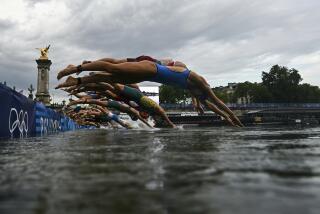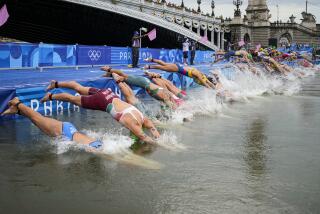Grueling Event Is a Real Survivor
- Share via
SYDNEY, Australia — The triathlon has always had an image problem.
In its early stages, in the 1970s, it was considered a pursuit of the athletically obsessed. Only a few truly dedicated athletes could attain and maintain the conditioning to compete in the Hawaii Ironman, which required an open-water swim of more than two miles, a bike ride of 112 miles and a marathon run, all performed under a tropical sun. It was considered a niche sport, an oddity, limited mostly to the San Diego area.
The heartbreaking collapse of Julie Moss during the 1982 Hawaii Ironman was a seminal moment for the sport. Inspired by Moss’ determination--she fell twice before finally crawling over the finish line, not knowing she had been passed by rival Kathleen McCarthy--triathletes launched themselves into the ocean, onto bikes and onto tracks by the thousands to test their endurance.
The course for Saturday’s first Olympic triathlon is tame by comparison to the sport’s early days. The 48 women--and 52 men a day later--will swim 1,500 meters (about a mile), scramble onto bikes and ride for 40 kilometers (nearly 25 miles) and finish with a 10K run (6.2 miles). Forecasts call for sunshine and a high of 71 degrees, although the water will be chilly, about 50 degrees.
The forecast has no warning about sharks, although nine shark-related incidents were reported around Sydney harbor earlier this year. Jellyfish may be a bigger concern, and one mildly stung Hunter Kemper of the United States last week.
“I think the jellyfish scared off all the sharks,” said Rob Barel of the Netherlands.
Organizers have downplayed concerns about sharks and have said the possibility of a close encounter is remote. However, they are allaying fears by sending six divers with electronic shark-repelling devices to escort swimmers through the course.
The equipment is called a shark POD (protective ocean device). It doesn’t hurt sharks, merely sending a current that makes them feel uncomfortable. But the divers may enjoy it.
“The backpack tingles,” according to Friday’s Sydney Morning Herald, “and the sensation is quite nice.”
The scenery above water should be quite nice too.
The course begins, ends and rarely strays far from the forecourt of Sydney’s magnificent Opera House, whose white, sail-like petals will provide a picturesque setting for one of the first medal events of the Games. The only better picture for Australians would be one of Aussie Michellie (pronounced Meh-KEE-lee) Jones standing atop the podium.
Jones, a two-time world triathlon champion who has lived in Southern California most of the last 10 years, is favored to get the host nation off to an early lead in the medal standings. Aussie Loretta Harrop ranks second in the world, and a third Aussie, Nicole Hackett, won this year’s world championship but ranks 17th. Fulfilling the expectations of an entire country, though, may be a burden.
“The pressure on the Aussies could work against them,” said Sian Brice of Great Britain.
Among the men, four-time world champion Simon Lessing of Britain is the favorite, but Dmitriy Gaag of Kazakhstan ranks first in the world, followed by Hamish Carter of New Zealand and Andrew Johns of Britain. The top-ranked U.S. entrant is Kemper, of Orlando, Fla. Ryan Bolton of Gillette, Wyo., and Nick Radkewich of Colorado Springs, Colo., are 43rd and 61st, respectively.
The top-ranked U.S. woman is Jennifer Gutierrez of Denver, who won the Olympic trials and ranks 13th in the world. Joanna Zeiger of Baltimore ranks 38th, and Sheila Taormina of Livonia, Mich., is 43rd.
Although Jones will be the sentimental favorite Saturday, Gutierrez believes the outcome is anything but certain.
“In doing approximately 30 World Cup races, I can say there are so many good women here people are forgetting,” said Gutierrez, a former Pepperdine swimmer. “With race tactics and stuff, there can be several people up on the podium.”
Ah, race tactics.
The most popular tactic is drafting, in which an athlete closely follows a leader in hopes of drafting off that athlete’s progress and conserving energy. It’s accepted in the swimming and cycling portions of the triathlon.
The top 15 competitors chose their starting positions on the swim pontoon first, followed by the rest of the field. Jones, a strong swimmer, chose the 39th position among the 48 starters; Gutierrez, also a strong swimmer, will start 41st. Taormina, who won a gold medal as a member of the 800 freestyle swimming relay at the Atlanta Games and is among the best swimmers in the world, chose to start 24th, where she can try to put some distance between herself and the rest of the field.
“It does make a difference if you can get near a good swimmer and stay on their toes,” Brice said.
There may also be team tactics, in which competitors work together to slow one portion of the race or box out rivals. Packs form quickly, making it difficult for laggards to gain ground.
“The start sets the tone for the rest of your race,” Gutierrez said. “We usually have four or five packs, and you want to be in that top pack if you can. If not, you figure out with the pack you’re in, how you’re going to get up there.”
*
Women’s Triathlon
4 p.m., Today PDT
TV: Saturday 7 p.m., Channel 4
More to Read
Go beyond the scoreboard
Get the latest on L.A.'s teams in the daily Sports Report newsletter.
You may occasionally receive promotional content from the Los Angeles Times.







